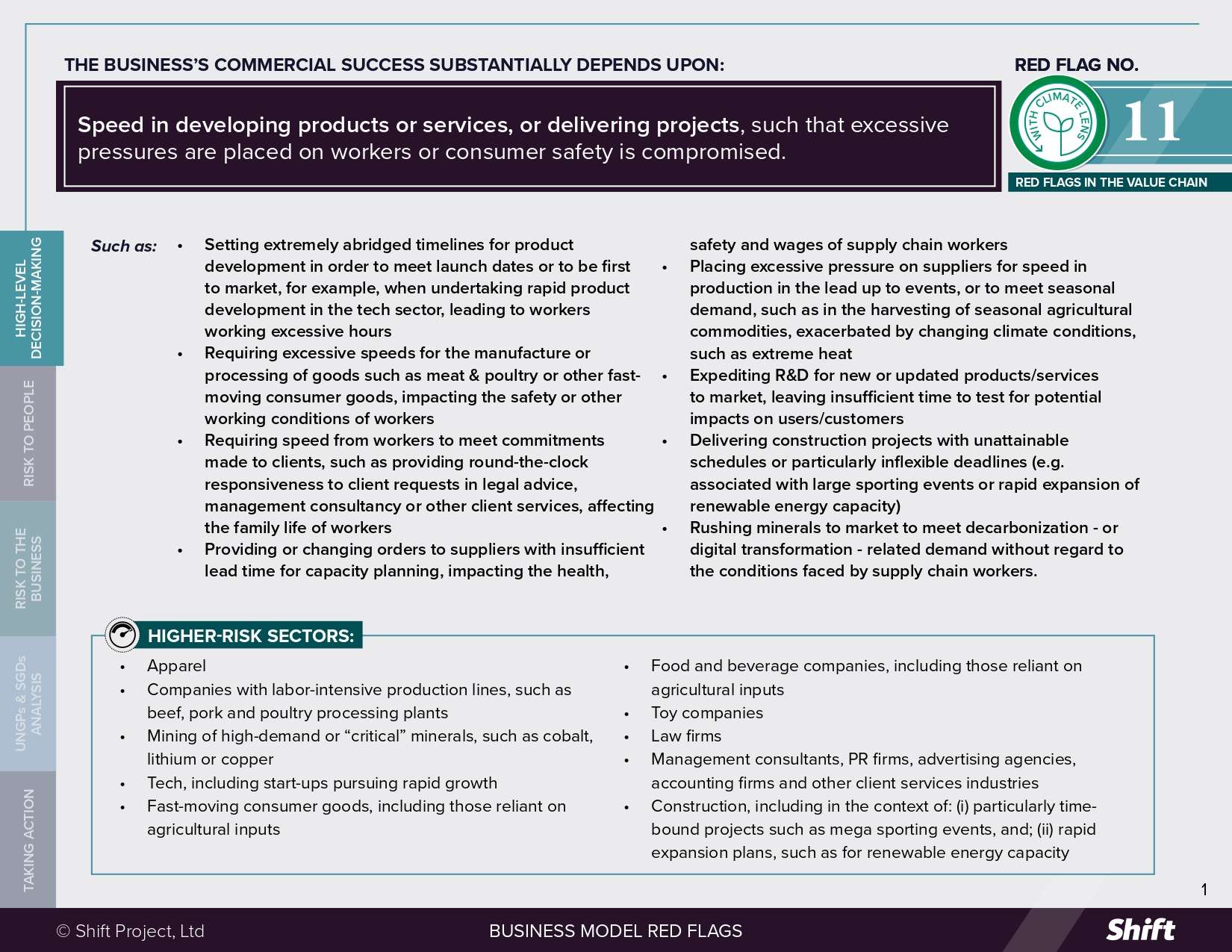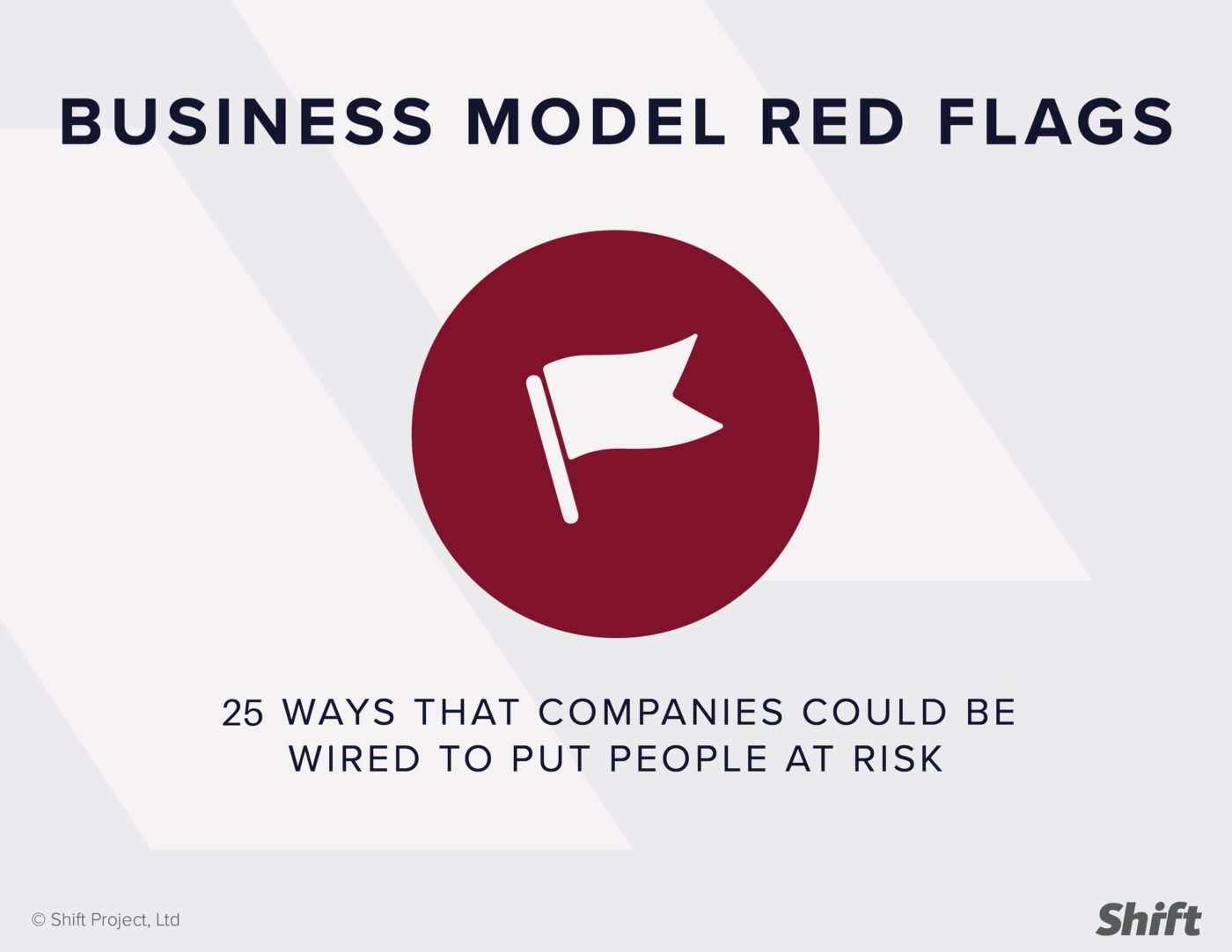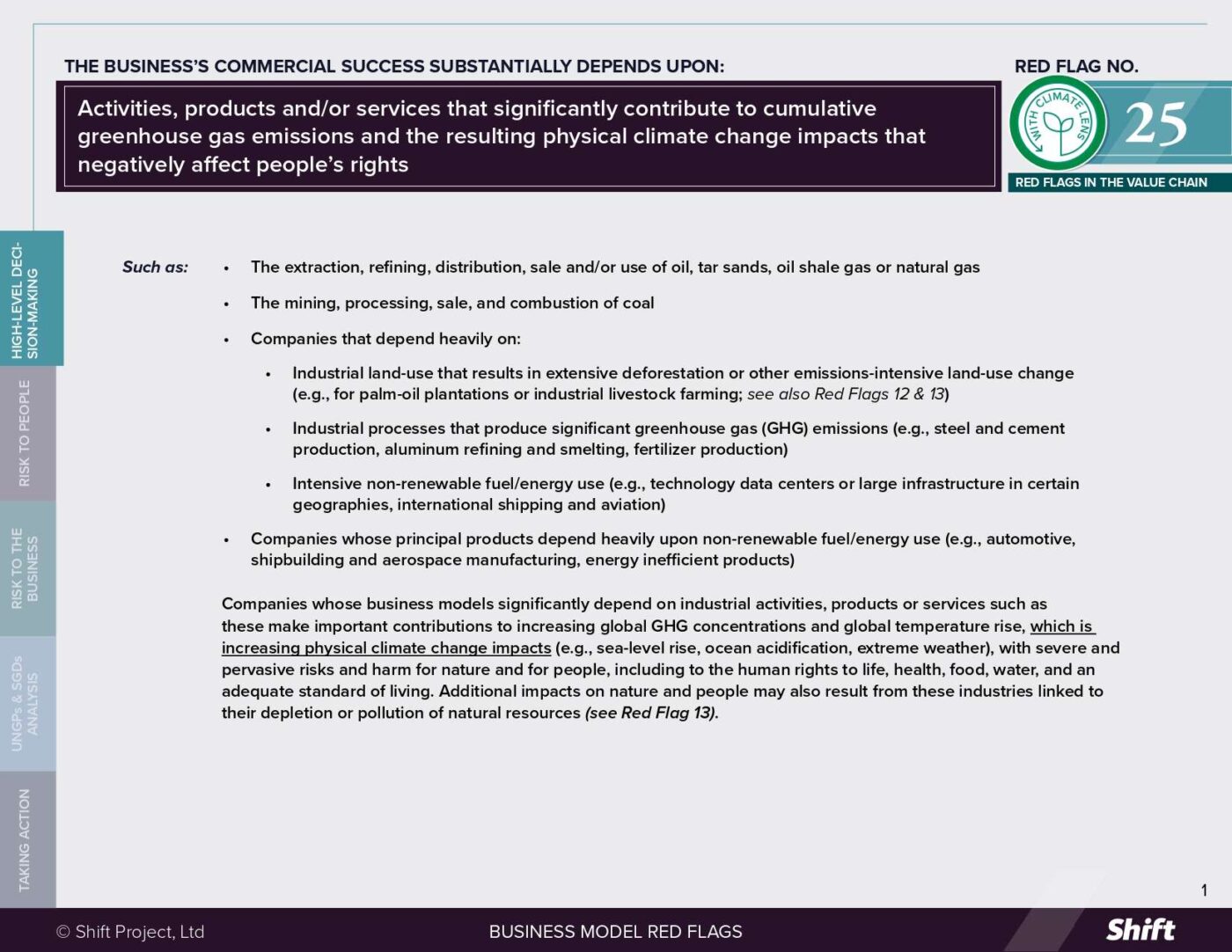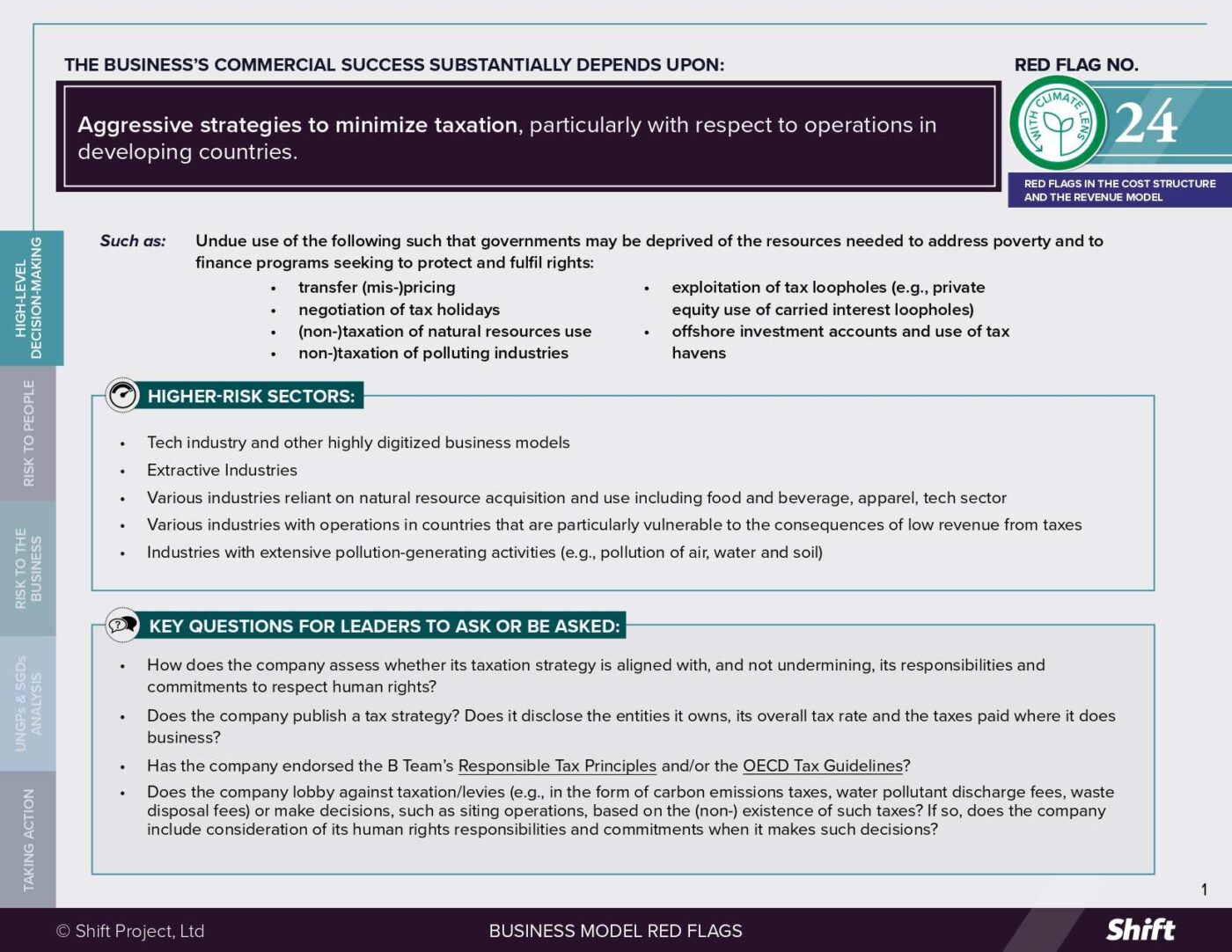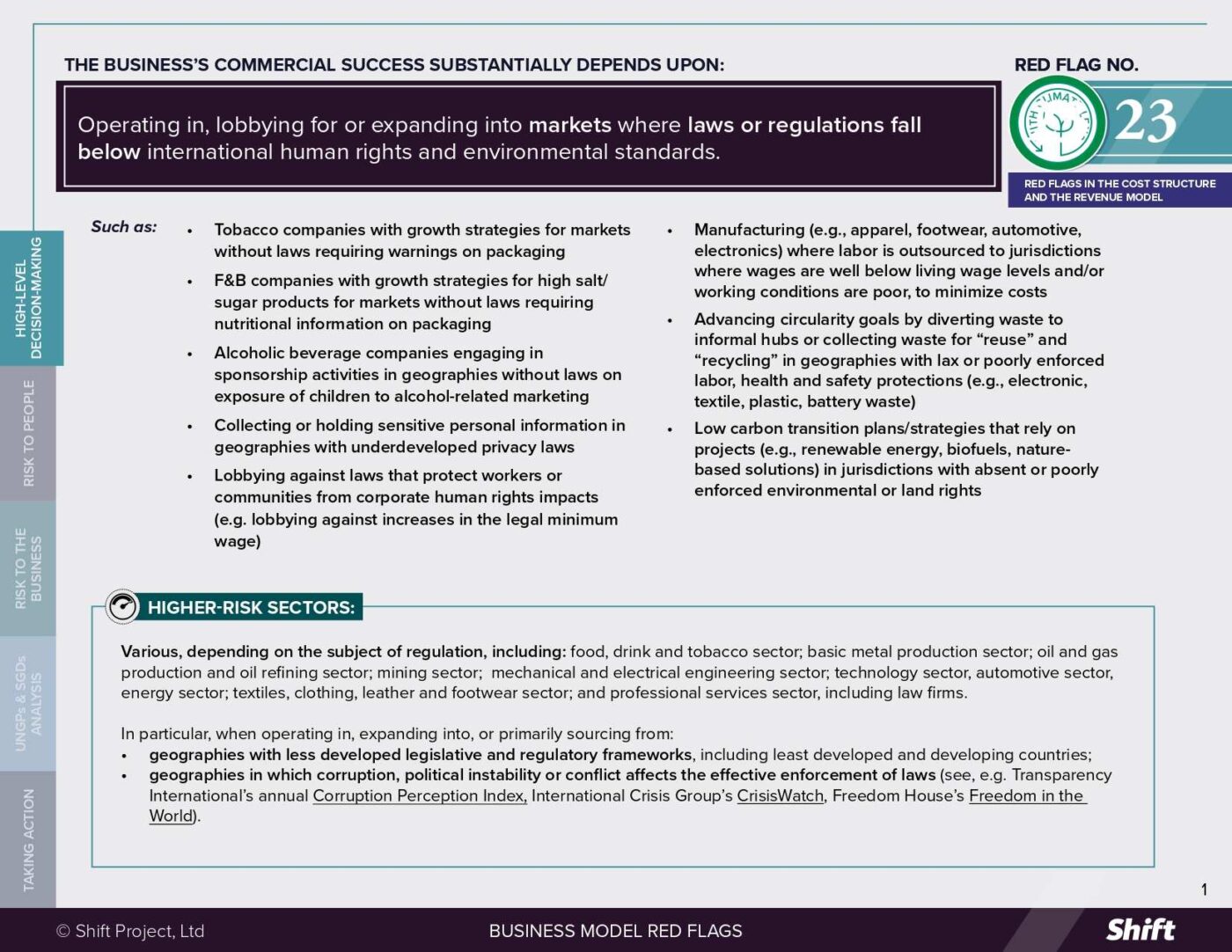RED FLAG # 11
The business’s commercial success substantially depends upon speed in developing products or services, or delivering projects, with risks to health and safety.
For Example
- Setting extremely abridged timelines for product development to meet launch dates or to be first to market, for example, when undertaking rapid product development in the tech sector, leading to workers working excessive hours
- Requiring excessive speeds for the manufacture or processing of goods such as meat & poultry or other fast-moving consumer goods, impacting the safety or other working conditions of workers
- Requiring speed from workers to meet commitments made to clients, such as providing round-the-clock responsiveness to client requests in legal advice, management consultancy or other client services, affecting the family life of workers
- Providing or changing orders to suppliers with insufficient lead time for capacity planning, impacting the health, safety and wages of supply chain workers
- Placing excessive pressure on suppliers for speed in production in the lead up to events, or to meet seasonal demand, such as in the harvesting of seasonal agricultural commodities, exacerbated by changing climate conditions, such as extreme heat
- Expediting R&D for new or updated products/services to market, leaving insufficient time to test for potential impacts on users/customers
- Delivering construction projects with unattainable schedules or particularly inflexible deadlines (e.g. associated with large sporting events or rapid expansion of renewable energy capacity)
- Rushing minerals to market to meet decarbonization – or digital transformation – related demand without regard to the conditions faced by supply chain workers.
Higher-Risk Sectors
- Apparel
- Companies with labor-intensive production lines, such as beef, pork and poultry processing plants
- Mining of high-demand or “critical” minerals, such as cobalt, lithium or copper
- Tech, including start-ups pursuing rapid growth
- Fast-moving consumer goods, including those reliant on agricultural inputs
- Food and beverage companies, including those reliant on agricultural inputs
- Toy companies
- Law firms
- Management consultants, PR firms, advertising agencies, accounting firms and other client services industries
- Construction, including in the context of: (i) particularly time-bound projects such as mega sporting events, and; (ii) rapid expansion plans, such as for renewable energy capacity
Questions For Leaders
- How does the company understand whether and to what extent the incorporation of speed in the value proposition impacts the human rights of workers, suppliers or other business partners?
- How does the company ensure that demands for speed in the R&D process leave sufficient time for considering and mitigating potential unintended impacts on customers/end users?
How to use this resource. ( Click on the “+” sign to expand each section. You can use the side menu to return to the full list of red flags, download this Red Flag as a PDF or share this resource. )
Understanding Risks and Opportunities
Risks to People
|
Speed is a key element of the value proposition and value chain in many business models. For some, speed is “transformative for how a business operates”, as “in today’s business environment, companies have to see value and quickly.” Speed in product innovation, speed to market, speed in delivery, speed in the preparation of targeted marketing campaigns that react to cultural events: the importance of speed as a competitive advantage is said to be increasing, with commentators stating that “with the pace at which society progresses, companies have to do whatever it takes to stay relevant.” Demands for speed in the business model become problematic from a rights perspective when they are absorbed in ways that place undue pressure on vulnerable people in the company’s operations and value chain. Demands for speed can have effects across the value chain, often on the most vulnerable people – such as young workers; factory workers, including migrant workers and women workers; and small-holder farmers. Some examples of impacts are below, with impacts on workers’ right to health, right to just and favorable conditions of work (including rest, leisure and adequate limitation of working hours), right to a family life, and in some cases where excessive hours are demanded, right to fair wages or right to a living wage for hours worked.
|
Risks to the business
Financial, Reputational and Business Continuity Risks:
-
Where taken to the extreme, speed of roll-outs has been noted as a factor in “tech product launch fail[ures].”
-
Where workers reach the limits of their capacity to absorb demands for greater speed, continued demands risk injuring and/or alienating the workforce. Employees may resist through the only means available where appropriate avenues to discuss the impacts of speed are unavailable:
-
in the poultry processing industry, following injuries and unmet requests from workers to slow line speeds, “workers began jamming chicken bones into the machinery to stop the processing line. It was the only way they could get some relief from the frantic pace.”
-
A group of Goldman Sachs junior bankers joined forces to develop a slide deck detailing extensive overwork, which circulated on social media and ultimately made headline news drawing attention to the grueling work culture of investment banking.
-
-
In instances where an industry’s reputation becomes synonymous with a speed-based business model, there is a risk of legal and regulatory action. For example, in 2021 the US Department of Agriculture issued a speed limit on hog slaughtering in the pork sector, as a result of a court ruling in favor of worker groups, which has financial implications for pork processing plants.
-
Where excessive speed is built into the business model, it can undermine sustainability efforts at the operational level. Moreover, increasingly savvy consumers, advocacy organizations and investors are looking beyond individual sustainability initiatives and programs and are quick to label them “greenwashing” if they perceive that the business model continues to increase the risk of negative impacts. A recent study of the five leading Spanish “fast-fashion” brands found that “many consumers perceive [sustainability] communication as greenwashing, resulting in negative impact on brands’ reputation.”
-
The prefixes “fast” or “ultra-fast” have developed negative connotations when associated with products (and industries producing such products) due to concerns about both environmental impacts and impacts on supply chain workers, as well as community and worker health. In 2022, Greenpeace launched a campaign against Singapore-based online fashion brand SHEIN, which it argues “forces suppliers to deliver at breakneck speed” resulting in a “business model built around the exploitation of the environment and people”. SHEIN, which is “one of the major players driving the acceleration of ultra-fast fashion” has also been the subject of OECD National Contact Point complaints in Belgium and France, alleging violation of the OECD’s MNE guidelines, including with respect to poor working conditions in the company’s value chain driven by excessive demands resulting from product delivery turnaround times.
What the UN guiding principles say
Where a company demands excessive speed from its workers, it may cause impacts on their health, safety or other working conditions. The company may also cause impacts if products are unsafe due to excessive speed in R&D phases.
Where a company’s purchasing practices create demands for speed in the supply chain, they may contribute to impacts caused by suppliers at different tiers in their chain, in their efforts to comply with these demands.
Possible contributions to the SDGs
Addressing impacts to people associated with this red flag can contribute to, inter alia:
-
SDG 8: Decent Work and Economic Growth, in particular
-
Target 8.8 on protecting, “labor rights and promot[ing] safe and secure working environments for all workers, including migrant workers, in particular women migrants, and those in precarious employment.”
-
Engagement with the human dimensions of “fast” business models can have positive environmental impacts, and contribute to Target 8.4, “Improve progressively, through 2030, global resource efficiency in consumption and production and endeavor to decouple economic growth from environmental degradation, in accordance with the 10-year framework of programmes on sustainable consumption and production, with developed countries taking the lead.”
-
Taking Action
Due Diligence lines of Inquiry
• Can we map where demands for speed are originating – both internally and externally to our business?
• How are demands for speed absorbed within our value chain and by whom? How do we know whether or to what extent those pressures are passed onto vulnerable workers in our value chain?
• How do we attempt to avoid or reduce such impacts and how do we know whether we are succeeding?
• What channels do we have for hearing concerns from our own workers, and workers in our value chain, related to any impacts from demands for speed, and to hear their views on how we could reduce these impacts? How do we know whether people feel able to use them?
• Do we involve internal human rights experts at the R&D stage to help identify potential risks to people from rapid product rollouts and adaptations?
Mitigation Examples
* Mitigation examples are current or historical examples for reference, but do not offer insight into their relative maturity or effectiveness.
Speed in the supply chain
-
Primark uses “off-season production to lengthen lead times and allow factories to plan their production more effectively and provide stable employment in typical low seasons.” This model may assist suppliers to manage fluctuating demand, including demands for speed from other buyers.
Speed in client services or financial firms
-
In response to public scrutiny of gruelling and unhealthy investment banking work culture, JPMorgan and Bank of America implemented measures to crack down on excessive working hours for junior bankers through work blackout periods, more rigorous tracking of work hours and imposing work limits of 80 hour/week.
Speed in Meeting Deadlines for Construction
-
In the construction context, researchers studying strategies to counter the effects of schedule pressure highlight the importance of, for example, attainable schedules, proactive planning and extensive communication with workers. Simulation models have highlighted two critical success factors for safety management in construction operations: managing rework and schedule delays. See further here.
Alternative Models
-
In the tech world, some have called for alternative business models, particularly for start-ups, that reframe success as long-term or organic growth.
-
Various “slow” movements (e.g., slow food, slow fashion, slow goods) have recognized the social and environmental advantages of reducing or eliminating the speed imperative from the business model.
-
Slow and Steady Wins the Race, which is a US clothing collection that creates classic garments and accessories made using simple, durable materials. The company introduces new styles at a regulated pace year-round, rather than the usual accelerated pace of the seasonal fashion schedule. Various other examples, including Patagonia and Boden, are detailed in the article “99 Sustainable Clothing Brands by budget”.
-
Other tools and Resources
On Production Lines
-
South Poverty Law Centre (2013) Unsafe at These Speeds.
-
Oxfam America (2015) Lives on the Line: The high human cost of cheap chicken
-
Human Rights Watch (2019) When We’re Dead and Buried, Our Bones Will Keep Hurting: Workers’ Rights Under Threat in US Meat and Poultry Plants.
On “Fast-Fashion” and supply chains
-
KnowTheChain is a resource for companies and investors to understand and address forced labour risks within their supply chains.
-
Center for Biological Diversity (2023) At What Cost? Unravelling the Harms of the Fast Fashion Industry
-
Business and Human Rights Resource Centre (2024) Shein, ultra-fast fashion and forced labour risks: Key issues for investors
On the slow movement
-
Good on you. (2023) What is Slow Fashion?
-
Slow Food is a global movement of local groups and activists united by the common goal of ensuring everyone has access to good, clean and fair food.
On Technology-based Start-ups
-
Medium, Stanier (2019) Silicon Valley’s Grow-or-Die Culture Is Costing Us: Startup founders must set a new tone instead of burning through their employees.
On Construction
-
Industrial Safety and Hygiene News, Leemann (2016) Deadlines can erode safety and promote risk-taking: Summarizes studies on the identification and mitigation of impacts from demands for speed in construction.
-
Buniya, M. et al. (2021) Barriers to safety program implementation in the construction industry, Ain Shams Engineering Journal, Volume 12, Issue 1.
On Just Transition
-
AIMprogress (2023) The Fast Moving Consumer Goods Sector and the Just Transition: The State of Play and the Road Ahead
-
Business and Human Rights Resource Centre (2024) Rush to renewables: Toward migrant worker rights and a just energy transition in the Gulf
Citation of research papers and other resources does not constitute an endorsement by Shift of their conclusions.

 Business Model Red Flags
Business Model Red Flags  Tool for Indicator Design
Tool for Indicator Design 